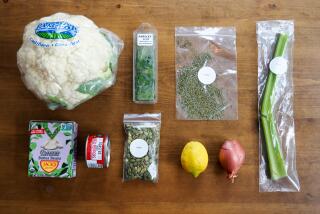Reducing Risk of Food Poisoning
- Share via
For most campers, picnics and meals cooked over an open fire are an important part of the outdoor experience. But food poisoning can spoil the picturesque scenario quickly.
At home and away, about 80 million people in the United States yearly contract food poisoning, ranging from mild to severe, according to estimates from the federal Centers for Disease Control and Prevention, and about 2,000 people die from it each year.
Proper food planning, storage and cooking techniques while camping can substantially reduce the risks.
“In planning for a camping trip, keep in mind how much refrigeration you will have,” said Dr. Shirley Fannin, director of communicable disease control for the Los Angeles County Department of Health Services. “Plan how you will refrigerate and cook foods.”
Dairy products and meat, in particular, need constant refrigeration. If they warm to 41 degrees or higher, organisms can start to breed, she said. Some meats and cheeses are less susceptible than others, with packaging and food preparation techniques playing a role in just how long foods can be warm before serious bacterial contamination begins. In bacon that is vacuum sealed, for example, the risk of contamination rises after it is opened, Fannin said. Salt contained in bacon helps hinder bacterial growth. But this does not mean that bacon will be safe if kept outside refrigeration. Like other meats, it requires cold temperatures to keep it safe. It just may not deteriorate quite as quickly as some other meats.
Campers using an ice chest must keep a steady supply of ice to maintain temperatures that are cool enough, she said. Another option is to put food in an airtight and watertight container and submerge it in a cold stream.
Having two coolers on a trip can help keep food safe, said Alicia Moag-Stahlberg, a Chicago dietitian and spokesperson for the American Dietetic Assn. “Store meats in a separate cooler, so it will not be opened and closed so much,” she said. “Use a second cooler for soda and other supplies.” If you take along milk, replace it with a fresh supply every day, she said. Or as an alternative, take powdered milk and add flavoring (chocolate, for example) to improve the taste. Use meats early in the camping trip.
Eggs and meats cooked over a campfire should be cooked thoroughly to minimize potential risks posed by contamination with salmonella bacteria.
Meals may also be planned around canned meat or fish (such as tuna) if refrigeration or other cooling methods are unreliable.
In circumstances that are less than pristine, it is important to avoid contaminating foods with bacteria on your hands. This can be done by maintaining good hygiene while camping, Fannin said. “Don’t forget to wash your hands before cooking. Don’t let the kids dip their fingers into things (such as food containers).”
Other tips to minimize food poisoning risks:
* Use clean dishes to serve cooked meat and never serve meat on the same dish used to carry raw meat to the grill or campfire.
* Take along plenty of dish towels and change them often; dirty towels can harbor bacteria.
* Wash hands after handling raw meat.
* Wash utensils and cutting surfaces used to prepare raw meat before preparing other foods.
* Meat should not be kept at room temperature for more than an hour after cooking. Return it to the cooler or refrigerator as quickly as possible after serving.
* Don’t put cooked meat back into an uncooked marinade. Don’t serve any marinade that held raw meat as a sauce until it is boiled to kill contaminants.
“Take along individual servings,” Fannin suggested, a practice that will especially appeal to young children. Instead of letting kids reach into boxes of crackers, put individual servings into small bags.
Investigate the variety of packaged, freeze-dried foods made especially for camping and sold at sporting goods stores. Such foods can be expensive on a per-serving basis but the menu choices are wide, including chicken teriyaki, scrambled eggs, vegetables and desserts. And many such foods can be prepared in the package, negating the need for cooking containers, which can be heavy and difficult to clean at campgrounds that may not have hot water.
Another option is to plan meals that don’t run the risk of contamination, Moag-Stahlberg said. Dried fruits, nuts and granola bars are good choices. “These foods are also high in carbohydrates and thus good sources of energy,” she added.
If food poisoning strikes despite a camper’s best efforts, knowing the early symptoms and when to seek medical help is important.
Symptoms vary with the type of organism contaminating the food. There can be nausea, vomiting, abdominal cramps and bloody diarrhea, depending on the organism. The onset of symptoms varies too, from only six or eight hours after eating to perhaps 36 hours later, experts said.
When should medical help be sought? If people are not feeling better after five or six hours (after onset of symptoms) and can’t keep food or fluids down, it is wise to seek help, Fannin said. Dry mouth may signal the need for medical attention.
Or if there is a fever of 101 or 102 degrees, or dehydration, seek medical help, Fannin added. The elderly and pregnant women should be especially attentive to symptoms, as should parents or guardians of young children. For these groups, it’s particularly important to seek help sooner rather than later.
The Healthy Traveler appears twice a month.


